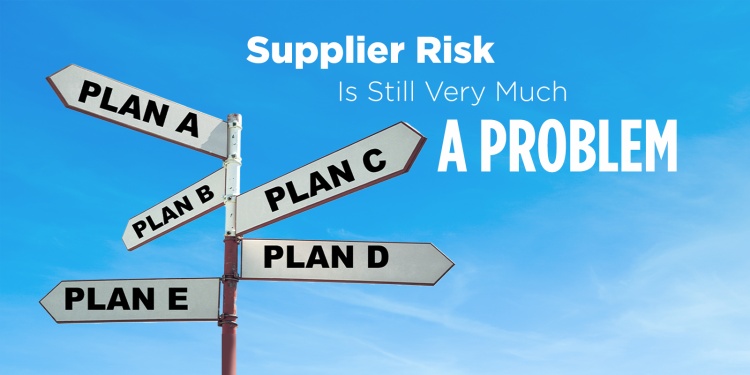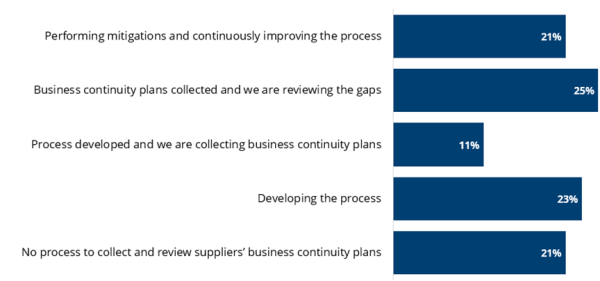
The best time to build a business continuity plan was before the COVID-19 pandemic, but the second-best time is now. Your organization—and especially your procurement team—should be armed with a robust, actionable business continuity plan that they’re continually refining and improving to prepare for the next disruption.
With 32 percent of supply chain professionals “extremely concerned” about the future of global supply chains in a recent APQC poll, it’s time to take a hard look at your organizations' suppliers and your plans for continuity in the face of interruptions from multiple causes beyond any one organization’s control.
Supplier risk is one of the biggest risk vectors organizations face today. Suppliers can expose your company to risk not only by failing to deliver materials or products on time and as specified, but also by engaging in practices that expose your company to regulatory and reputational repercussions.
WHY WORRY? BECAUSE SUPPLIER RISK IS MULTI-FACETED
Modern supply chains are deeply complex and interwoven. Thus, what first appears as a small or isolated problem within one part of the supply chain can create a ripple effect that impacts the rest of the chain and the businesses that depend on it. Over the past several years, the importance of understanding and mitigating supplier risk has increased due to COVID-related lockdowns, shortages, logistics challenges, staffing shortages, strengthened regulatory requirements, governmental conflicts, and greater consumer awareness of supply chains.
Supplier risk refers to the likelihood that a supplier will fail to deliver on its commitment and thereby cause harm to your company. Supplier risk includes:
- Strategic and financial risk (e.g., your supplier can no longer provide the material/product, forcing a change to your company’s strategy and bottom line)
- Legal risk (e.g., the supplier fails to comply with contracts and/or applicable regulations, exposing your company to legal problems)
- Operational risk (e.g., the supplier fails to provide the material/product on time and with specified quality, thereby creating delays or disruptions in production and/or delivery of final product to customers)
- Reputational risk (e.g., the supplier engages in labor or environmental practices that bring negative publicity to your company)
- Cyber risk (e.g., vulnerabilities in the supplier’s IT environment provide a back door into your company’s critical data and systems)
BUSINESS CONTINUITY PLANS
A business continuity plan is a blueprint for ensuring the continued delivery of products/services at acceptable levels following a disruption. The process of developing a business continuity plan empowers your organization to not only respond to a potential crisis, but also proactively mitigate your organization’s risk exposure. Organizations develop general business continuity strategies to prepare contingency plans for their people and facilities when faced with large-scale disruptions such as environmental disasters, infrastructure problems, wars, terrorism, pandemics, and so on. In fact, recent events may have forced some organizations to activate their contingency plans.
Given current supply chain issues and the degree to which organizational resiliency hinges on supply chains, organizations should either incorporate supplier risk mitigation plans into their existing business continuity plans or develop specific business continuity plans for supply chain with their procurement teams.
You should incorporate the following steps in creating your business continuity plan:
- Prioritize supplied materials/products
- Assess the risk of current suppliers
- Develop a list of vetted alternative suppliers for critical and/or at-risk materials/products
- Define processes for how and when to engage alternative suppliers depending on the criticality of materials/products and the level of risk
APQC’s research finds that many organizations need to move faster with developing, implementing, and continuously improving their business continuity plans. Before the pandemic, we asked supply chain professionals about their maturity in collecting and reviewing suppliers’ business continuity plans, and 44 percent had not reached the stage of collecting them. Only about one-fifth said they were performing mitigations and continuously improving their business continuity planning process (Figure 1).
Maturity of Process to Collect and Review Suppliers’ Business Continuity Plans
Figure 1
KEY TAKEAWAYS
In our current moment, understanding and mitigating supplier risk is more important than ever before. APQC recommends that organizations build robust business continuity plans that incorporate supplier risk based on prioritized supplied materials/products and risk assessments of specific suppliers. These plans should also provide actionable guidance for how and when to engage alternative suppliers based on risk level and criticality of materials/products. In a business environment that is riddled with shortages, those who have the plans, knowledge, and processes to find alternative sources faster than others stand to gain a significant competitive advantage.
TO LEARN MORE
There are many templates available for organizations that want to get started with business continuity planning. A good starting point is ready.gov/business, which offers a free business continuity planning template, a free software suite, and a wealth of supporting guidance, exercises, toolkits.
For additional guidance from APQC, check out this collection of content: APQC Supply Chain Collaboration with Rutgers University, and specifically this article: Addressing Supplier Risk with Business Continuity Plans which is based on research performed by MBA Students at Rutgers University in collaboration with APQC.
I also recommend this infographic and this short report: The Impact of Supply Chain Disruptions: 2022 Quick Poll Results.
To continue the conversation, follow Marisa on Twitter at @MB_APQC, or connect with her on LinkedIn.
